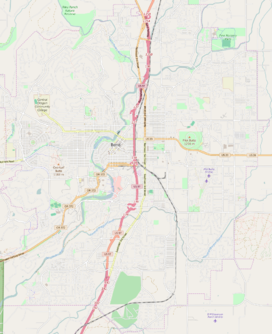| Pilot Butte | |
|---|---|
 | |
| Highest point | |
| Elevation | 4,142 ft (1,262 m) NAVD 88[1] |
| Coordinates | 44°03′38″N 121°17′00″W / 44.060540764°N 121.283235542°W[1] |
| Geography | |
| Parent range | Cascades |
| Topo map | USGS Bend |
| Geology | |
| Rock age | Less than 780,000 years[2] |
| Mountain type | Cinder cone |
| Volcanic arc | Cascade Volcanic Arc |
| Climbing | |
| Easiest route | Road |
Pilot Butte is a lava dome that was created from an extinct volcano located in Bend, Oregon. It is a cinder cone butte which rises nearly 500 feet (150 m) above the surrounding plains. Bend is one of six cities in the United States to have a volcano within its boundaries. The other examples are Mount Tabor in Portland, Oregon, Jackson Volcano in Jackson, Mississippi, Diamond Head in Honolulu, Glassford Hill in Prescott Valley and Pilot Knob in Austin, Texas.
The 114.22-acre (46.22-hectare) Pilot Butte State Scenic Viewpoint, presented as a gift to the State of Oregon in 1928, is a Bend icon. Pilot Butte itself is a popular hiking destination with two trails to the summit, each gaining about 490 ft (150 m) in elevation. There is also a 1.8-mile (2.9 km) trail around the base of the butte. A scenic road also winds up and around the cone. In 2018, the park was the most visited Oregon state park east of the Cascade Mountains. From the top, the entire city of Bend is visible, as well as several major Cascade peaks including Mount Bachelor, Broken Top, and the Three Sisters, located about 20 mi (32 km) to the west. Bend launches fireworks from Pilot Butte every Independence Day.
- ^ a b "Pilot Butte". NGS Data Sheet. National Geodetic Survey, National Oceanic and Atmospheric Administration, United States Department of Commerce. Retrieved April 2, 2008.
- ^ "USGS Geologic Investigations Series Map I-2683, pamphlet" (PDF). U.S. Department of the Interior and U.S. Geological Survey. 2004. Retrieved October 28, 2018.

